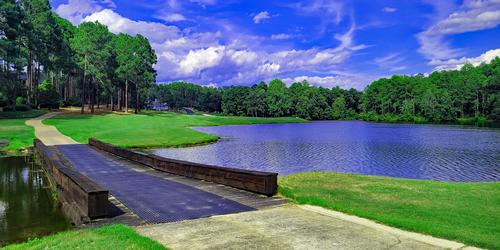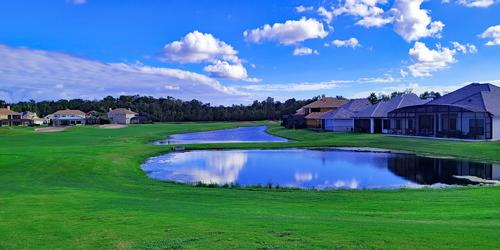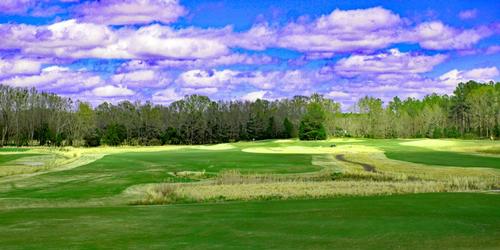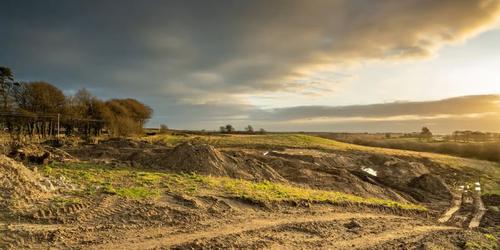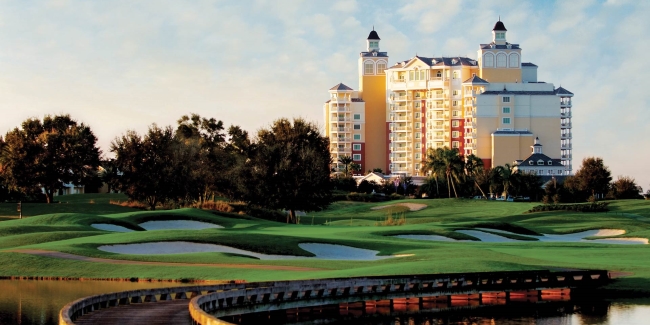
Reunion Resort
Three World Class Courses by Three World Class Golfers
By David Theoret
Reunion Resort is located off of I-4 at exit 58, and then east about 1 mile. Reunion features spacious accommodations, personalized concierge services, world-class dining, and a bevy of other amenities. And let's not forget the golf - three top-notch courses designed by three of golf's greatest players: Arnold Palmer, Jack Nicklaus and Tom Watson. The courses are open to members and resort guests only with stay and play packages available year round (two-night minimum stay required).
Reunion has been recognized by the Florida Department of Environmental Protection's Green Lodging Program. Reunion Resort offers so much more than any hotel or hotel room. It's designed for friends and families who want to be on vacation together, rather than be split up among different floors in a hotel. Spacious villas, quaint condos, five bedroom homes and everything in between provide a variety of options for accommodations. On property you will find a variety of amenities including horse stables, tennis courts, a state-of-the-art spa and fitness center, a water park and swimming pools in various locations, miles of biking and hiking trails plus shopping and multiple dining options in Reunion Square. What more could you ask for in a vacation - and we haven't even started talking about golf!
Annika Academy
Reunion Resort is also home to the Annika Academy - Annika Sorenstam's signature training facility. It's located at the driving range that serves the Watson and Palmer courses and is housed in a spacious 5,400 sq. ft. facility, The Academy offers a modern fitness room, full-service locker rooms, and large hitting booths for covered swing training, video analysis and Callaway Golf club fitting.
The Nicklaus Course
Formerly known as The Tradition Course, this Jack Nicklaus (and Jack Nicklaus II) Signature course plays 7,244 yards from the back tees with a course rating of 76.7 and a slope of 147. The white tees measure considerably less at 6,260 yards but still carry a rating of 71.3 and a slope of 140. The Nicklaus Course was the last of the three to open and offers four sets of tees, providing a challenge for all golfers.
The Nicklaus Course is a Parkland-style layout that was labeled by Golfweek as one of the Top 100 Resort Courses in 2009 and ranked it #17 on its Best Courses You Can Play list in 2010. The course follows the natural contour lines of the land in the area; water comes in to play on 9 of the eighteen holes - much less than most Florida courses. A wide variety of trees can be found along the way including: oaks, magnolias, maples, and palms.
There is a lot of undulation in the course both in the fairways and especially on the greens. There are more than 100 bunkers on the course, as well as small, postage-stamp greens, and a few forced carries. Tee boxes are beautifully landscaped and well maintained, fairways are meticulously trimmed and groomed, and the greens deserve their own article! Many of them are elevated and surrounded by evil bunkers and waste areas.
Because the course was completed during the downfall of the golf and housing boom there is no clubhouse. It has its own practice facility which includes an 1,100 ft. driving range with grass tees, a short game area, practice putting green and a separate Nicklaus Putting Course. Unfortunately the putting course was closed during our visit. The Nicklaus Course is a three minute drive from the clubhouse of the other two - providing there is no traffic in the roundabout.
Memorable Holes (All yardage is from the white tees)
Number 2. Par 4, 402 yards. The conservative play on this demanding par 4 is to aim down the left side of the fairway, between the two fairway bunkers. A more aggressive line down the right side and over the bunkers will leave a much shorter approach shot but runs a high risk of finding trouble. The forced carry off the tee should not prove difficult. Club selection is everything as you approach this multi-tiered green; finding the front left bunker is a very tough up and down. Par is a good score here.
Number 3: Par 5, 536 yards. Water rears its ugly head on the layout's first par 5. Avoid the right side at all costs; it is replete with trouble in the form of bunkers, and water. There is plenty of room out to the left. Ideally you want to play your tee shot down the left center of the fairway; for most, this is a three shot par 5. Again, favor the left side on your layup and leave yourself a short chip shot into a small target green. Three well played shots can lead to a well-deserved birdie opportunity.
Number 6. Par 5, 500 yards. The ideal line off the tee is just left of center. Long ball hitters can take their best shot at hitting over the bunkers down the right side, setting up a much easier layup and approach or the opportunity to go for the green in two. The green is elevated and will require distance control if you want to get it close.
Number 10: Par 4, 390 yards. This long par 4 requires a booming drive straight down the fairway. Clear the fairway bunkers on the right side and life gets a lot easier. The waste bunker on left shouldn't come into play. If it does, a trip to the Annika Academy might be a good idea! Knowing your yardage on approach is necessary as there is easily a two-club difference between front and back pin placements. The green is long, narrow and protected front left by a very imposing bunker. Holding the green in two here is an accomplishment and the undulating green will challenge the best of putters.
Number 14. Par 4, 388 yards. If you have any say in it, play your tee shot down the right side of the fairway. Danger looms right in the form of a large waste bunker and water which may be reachable for long ball hitters. Should you end up on the right side, discretion is the better part of valor; there is no room for error as the small target green is guarded on the left side by water. There is also a large collection area to the right for those of you bent on avoiding the water hazard.
Number 16: Par 3, 177 yards. Make sure you take the right club off the tee; anything short will most likely lead to an undesirable number on the scorecard. Number 16 is the signature sixteenth hole and features a daring carry over water to a shallow firm green protected in front and back by deep bunkers. Holding this putting surface is a challenge if you hit the ball with a low trajectory.
Number 18: Par 5, 545 yards. A great opportunity to finish on a good note. Keep right off the tee and avoid the two large waste bunkers. The pot bunker in front of the green will keep many players for going for the green in two. Keep right again on your layup shot, avoiding the pot bunkers that dot the right side and leave yourself a short approach setting up a birdie opportunity and a spectacular finish!
Last Word
The Nicklaus course is not your typical resort course; it's more of a "player's" course. Scoring well here requires a significant amount of accuracy off the tee - anything hit wide left or right will either be irretrievable or in some sort of hazard - most likely a waste bunker. A player who is more of a thinker as opposed to someone who wants to grip it and rip it will prevail.
There are a lot of bunkers and waste areas along the way, both sand and waste. Many have been placed strategically in the landing areas which again places an emphasis on accuracy off the tee. A few times I found myself putting the driver back in the bag and pulling out a fairway wood in an effort to take the fairway bunkers out of play.
The green complexes are what make the Nicklaus Course truly challenging. Most holes have modestly elevated greens although a few are very significant. The way these green complexes are set up and bunkered, a bump-and-run approach shot is not usually an option unless you are skilled at running the ball through a bunker! Most greens require you to fly the ball on to the putting surface. Once there, the subtle little undulations of the green take over. Be sure to study all putts carefully, even the tap-ins; there are not a lot of straight putts out here.
My only knock on the course is there is a large drop in yardage between the white tees (6,260 yards) and the red tees (5,055 yards). My advice would be to create a tee somewhere in the middle using a combination of red and white tee boxes. I did that for a couple of players in our group and came up with a yardage of around 5,600 yards. This is the perfect distance for seniors on this caliber of course.
The course is in great shape year round and the grounds crew is painstakingly meticulous. Staff is friendly and helpful, especially the starters. If you haven't played the course before, listen to them carefully. They will give you a wealth of information. If you're in the area, you owe it to yourself and your golf game to play the Nicklaus Course at Reunion Resort. After all, it's the perfect destination for a great round of golf on one of three fabulous courses designed by three of golf's greatest players. It's also a great spot for a family vacation. Come to think of it, why not do both?
For more information on The Nicklaus Course or any of the other great courses, call Reunion at 866-880-8563 or visit them online at www.reunionresort.com.
Revised: 06/23/2014 - Article Viewed 31,449 Times
- View Course Profile
About: David Theoret
![]() David Theoret has been in the golf and golf travel industry for over 10 years, primarily selling online advertising. For the past seven years, he has also been a golf writer, reviewing golf courses, resorts, destinations, equipment, golf apparel, and training aids - the latter of which never seems to help. David's articles and reviews have been posted on many golf travel and equipment websites.
David Theoret has been in the golf and golf travel industry for over 10 years, primarily selling online advertising. For the past seven years, he has also been a golf writer, reviewing golf courses, resorts, destinations, equipment, golf apparel, and training aids - the latter of which never seems to help. David's articles and reviews have been posted on many golf travel and equipment websites.
Growing up in Southwestern Ontario, Canada, it was naturally assumed he would play hockey. Beginning at the age of 3 and continuing into his late 30's, he did just that. However, after one too many pucks to the head, he realized that golf was a lot easier on the body (whoever said hockey players were slow) and took the game up.
After moving to Florida and accepting a position with TravelGolf Media (now part of GolfNow) his love for the game grew exponentially. Most Saturdays you will find him on a course somewhere in Florida or on the practice range reinforcing his bad habits. David plays to a 10 handicap - unless there is money involved in which case it goes considerably higher. He currently resides in Lakeland, FL with his wife Belinda and their two "kids", Madyson and Molly.
Contact David Theoret:
GolfTrips.com - Contributor





